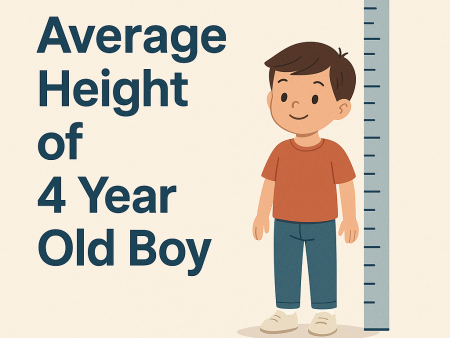Parents often wonder if their child is growing at a healthy and typical rate. One of the most common questions revolves around height, especially during the pivotal years of development. For 10-year-old boys, this curiosity is no different, as it’s an age when growth spurts can vary widely.
Understanding the average height for a 10-year-old boy can provide reassurance or highlight the need for fur
Convert your height in m, cm, feet and inches to compare
0' 0" is equal to 0.0 cm or 0.00 m.
Parents often wonder if their child is growing at a healthy and typical rate. One of the most common questions revolves around height, especially during the pivotal years of development. For 10-year-old boys, this curiosity is no different, as it’s an age when growth spurts can vary widely.
Understanding the average height for a 10-year-old boy can provide reassurance or highlight the need for further discussion with a healthcare provider. While every child grows at their own pace, having a general idea of what’s typical can help parents feel more informed about their child’s development.
Understanding The Average Height For A 10 Year Old Boy
The average height for a 10-year-old boy in the United States is approximately 54.5 inches (138.4 cm), based on data from the Centers for Disease Control and Prevention (CDC). This measurement represents the 50th percentile, meaning that half of boys this age are taller, while the other half are shorter.
Growth patterns vary widely, influenced by genetics, nutrition, and overall health. For example, boys with parents of above-average height are likely to grow taller, while those facing nutritional deficiencies may not reach their full potential. It’s common for boys at this age to experience growth spurts, though the timing and extent of these spurts differ for each child.
Healthcare providers use height percentiles from growth charts to track development. If a 10-year-old boy’s height falls significantly below the 3rd percentile, they might evaluate for underlying health conditions, but typical variations often don’t indicate issues. Understanding these ranges helps parents focus on holistic well-being rather than isolated measurements.
Factors Influencing Height
Several elements play a role in determining a 10-year-old boy’s height. Genetics, nutrition, physical activity, and health conditions significantly impact growth patterns during this developmental stage.
Genetics
Genetics is the primary determinant of height. Parents’ height often sets the framework for a child’s growth potential. Boys with taller parents tend to inherit traits for above-average height, while shorter parents generally pass on genes for shorter stature. Although genetic factors are dominant, they interact with external influences like nutrition and health.
Nutrition
Nutrition directly affects a child’s ability to achieve their genetic height potential. A well-balanced diet rich in proteins, vitamins (e.g., vitamin D), and minerals (e.g., calcium and zinc) supports bone and muscle development. Deficiencies, such as insufficient calorie intake or low iron levels, can impede growth patterns. Studies link malnutrition to stunted growth in childhood.
Physical Activity
Physical activity aids in healthy growth by promoting bone density and supporting hormone regulation. Weight-bearing exercises, like running or jumping, positively impact skeletal development. Sedentary lifestyles, on the other hand, may restrict these growth benefits and overall physical health.
Health Conditions
Health conditions influencing height include hormonal imbalances, chronic illnesses, or congenital disorders. Low levels of growth hormone or conditions like hypothyroidism may result in below-average height. Chronic diseases, such as asthma or celiac disease, can also indirectly impact growth due to nutrient absorption issues or prolonged treatments. Early diagnosis and management ensure better growth outcomes.
Global Averages And Variations
The average height for a 10-year-old boy varies across different regions and time periods, influenced by environmental, genetic, and socioeconomic factors.
Regional Differences
Average height differs worldwide due to variations in genetics, nutrition, and healthcare access. For example, boys in Northern European countries, such as the Netherlands, often exceed 55 inches (140 cm) at this age, whereas boys in certain parts of South or Southeast Asia may average closer to 53 inches (134.6 cm). In regions with high rates of undernutrition or limited access to healthcare, growth potential can be stunted compared to areas with better living conditions. Urban populations typically show higher averages than rural populations, reflecting disparities in nutrition and health services.
Historical Trends
Over the last century, the average height for 10-year-old boys has increased globally, reflecting improvements in nutrition, sanitation, and healthcare. In the early 1900s, boys in the United States averaged approximately 51.5 inches (130.8 cm), growing to today’s average of 54.5 inches (138.4 cm). Similar trends have been observed in Europe, East Asia, and other regions experiencing socioeconomic growth. However, this increase has plateaued in some developed countries, suggesting that genetic potential has reached its limit in these populations. Conversely, in developing regions, continued progress in health and nutrition may still contribute to gradual increases.
How To Support Healthy Growth
Promoting healthy growth in children involves focusing on key lifestyle factors such as nutrition, physical activity, and regular health assessments. These elements help ensure a child reaches their growth potential.
Importance Of A Balanced Diet
Providing a nutrient-rich diet is essential for supporting growth during childhood. Key nutrients like calcium, protein, vitamin D, and zinc contribute to bone density, muscle development, and overall stamina. Examples of nutrient sources include dairy products for calcium, lean poultry and beans for protein, fatty fish for vitamin D, and nuts and seeds for zinc. A lack of these nutrients can slow growth and weaken overall health.
Encouraging Regular Exercise
Physical activity has a critical role in stimulating growth by enhancing bone strength and supporting healthy hormone levels. Weight-bearing exercises like running, jumping, or playing sports help improve bone density. Activities like swimming or yoga benefit posture and flexibility. Limiting sedentary habits such as excessive screen time further encourages growth-supporting activity levels.
Monitoring Development
Tracking a child’s height, weight, and overall growth pattern allows potential concerns to be addressed early. Using consistent doctor visits, parents can identify irregularities like slowed growth rates or disproportionate measurements that may indicate health issues. Consulting healthcare professionals ensures that underlying conditions, such as nutritional deficiencies or hormonal imbalances, are effectively managed. Regular documentation of growth charts also provides a clear reference for progress over time.
When To Consult A Doctor
Parents might want to consult a doctor if their 10-year-old boy shows significant growth delays or unusual height patterns compared to peers. Signs such as height falling below the 3rd percentile or a lack of growth over six months can indicate underlying health issues.
Medical conditions could cause growth failure, including hormonal imbalances like growth hormone deficiency or thyroid problems, chronic illnesses such as celiac disease, or genetic disorders like Turner syndrome. Identifying these issues early can help improve outcomes.
Delayed puberty may also signal growth concerns. Boys who haven’t begun puberty-related changes by age 14 or show no signs of a growth spurt by mid-puberty could require evaluation. Factors like late bone development or hormonal delays are sometimes involved.
Doctors may recommend testing to assess growth, such as measuring growth hormone levels, conducting genetic testing, or evaluating bone age with an X-ray. Regular medical check-ups help track growth trends and ensure timely intervention if needed.
Conclusion
Understanding the average height for a 10-year-old boy is just one piece of the puzzle when it comes to a child’s growth. Every child grows at their own pace, influenced by a mix of genetics, nutrition, activity levels, and overall health. While averages can provide a helpful reference, they shouldn’t overshadow the importance of nurturing a child’s unique development.
Parents play a vital role in supporting healthy growth by encouraging balanced nutrition, regular physical activity, and routine health check-ups. Staying mindful of potential growth concerns and seeking medical advice when needed ensures children have the best chance to thrive. Growth is a journey, not a race, and focusing on overall well-being helps children reach their full potential both physically and emotionally.
Frequently Asked Questions
What is the average height of a 10-year-old boy?
The average height of a 10-year-old boy is approximately 54.5 inches (138.4 cm), according to the CDC. This measurement represents the 50th percentile, meaning half of boys this age are taller, and half are shorter. However, individual growth depends on various factors like genetics, nutrition, and overall health.
What factors influence height in boys?
Height in boys is primarily influenced by genetics, but nutrition, physical activity, and health conditions also play significant roles. A well-balanced diet, regular exercise, and good overall health support optimal growth, while chronic illnesses or hormonal imbalances may hinder it.
How does parental height affect a child’s growth?
Parental height significantly impacts a child’s growth because genetics set the framework for their growth potential. Generally, taller parents tend to have taller children, while shorter parents are more likely to have shorter children. Other factors, like nutrition and health, also influence height.
How can I support my child’s healthy growth?
To support healthy growth, ensure your child has a well-balanced diet rich in calcium, protein, vitamin D, and zinc. Encourage regular physical activity, such as sports or outdoor play, and limit sedentary habits like excessive screen time. Regular health check-ups are essential for tracking growth.
Are there global variations in the height of 10-year-old boys?
Yes, the average height of 10-year-old boys varies globally due to genetic, environmental, and socioeconomic factors. For example, boys in Northern Europe may average over 55 inches (140 cm), while those in parts of South Asia may average closer to 53 inches (134.6 cm).
When should I be concerned about my child’s growth?
Consult a doctor if your child shows significant growth delays, has unusual patterns (e.g., below the 3rd percentile), or hasn’t grown over six months. Boys not showing puberty-related changes by age 14 should also be evaluated for potential medical conditions.
What health conditions can affect a child’s height?
Conditions like hormonal imbalances, genetic disorders, chronic illnesses, or delayed puberty can impact a child’s height. If identified early through medical tests or check-ups, these conditions can often be managed to support better growth outcomes.
Has the average height of children changed over time?
Globally, the average height of children has increased over the last century due to improved nutrition, healthcare, and sanitation. However, this growth plateaued in some developed countries, while developing regions may still see gradual increases due to ongoing health advancements.
How do I track my child’s growth effectively?
You can track your child’s growth by measuring height and weight regularly and comparing these metrics to standardized growth charts. Regular medical check-ups are crucial for identifying growth trends and addressing any potential health concerns early.
Does physical activity help improve a child’s growth?
Yes, physical activity supports healthy growth by promoting bone density, hormone regulation, and overall health. Activities like running, jumping, and playing sports are especially beneficial. Limiting sedentary behaviors is equally important for optimal development.





